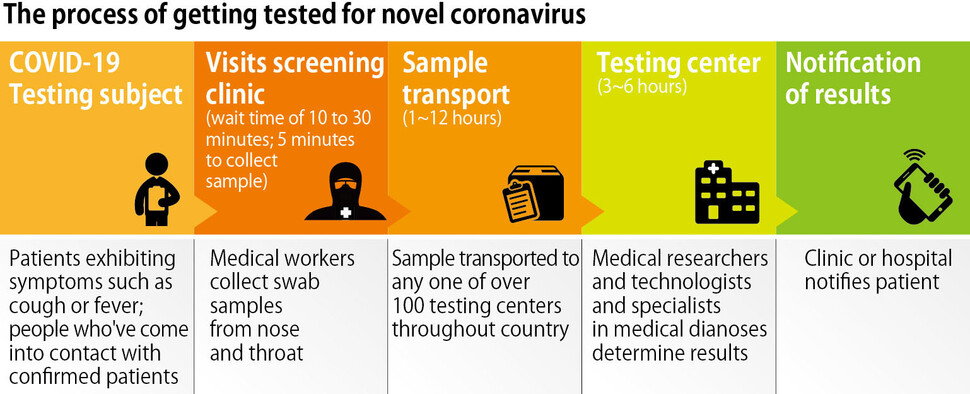hankyoreh
Links to other country sites 다른 나라 사이트 링크
Takes around 9 hours to get novel coronavirus testing results

Kim Jeong-hun (pseudonym), 31, visited a hospital on Mar. 12 because of a cough and a runny nose. On the doctor’s recommendation, he was tested for COVID-19, the disease caused by the novel coronavirus, at 11 am that same day. It wasn’t until 8 pm that he was informed over the phone that the test had come back negative. What happened during the nine hours between Kim’s visit to the screening center and the news about his test results?
Kim visited a screening center attached to a hospital in Busan. After waiting around 10 to 20 minutes, he was ushered in to meet doctors in medical masks and Level D protective gear, the kind he’d seen on the news. The doctors used a cotton swap to collect a sample from the back of Kim’s nose and throat, a process that took just over five minutes. Now all that Kim had to do was go home and wait for the results.
Like other patients, Kim didn’t get to see what happens next. The doctors at the screening center deposit the cotton swabs into an air-tight container, screw on the lid, and place it in three layers of packaging. The container is then handed to an emergency worker or courier who transports it to a testing site with a DNA amplifier, also known as a thermal cycler.
There are over 100 such testing sites around the country, including public health labs run by each local government and institutions to which the work is outsourced. Medical staff send samples to the appropriate site, considering the caseload there and the distance from the screening center. If the hospital that runs the screening center has a testing room of its own, the samples might be sent there immediately. Regardless of where they’re sent or how they get there, the samples, along with documentation containing relevant information, is delivered to a DNA amplifier within three or four hours.
The testing worker who receives the sample removes the three layers of packaging. After checking the documentation to ensure it’s the right sample, they extract ribonucleic acid, or RNA. They then mix the RNA with the COVID-19 diagnostic reagent, insert it into the DNA amplifier, and turn the device on. The results are viewed by a public health researcher or a specialist in medical diagnosis, who makes the final call about whether the test is positive or negative according to guidelines provided by South Korea’s Centers for Disease Control and Prevention (KCDC).
It typically takes an hour to extract the RNA and two hours to confirm the results of the DNA amplification, known as polymerase chain reaction (PCR), about three hours altogether. “When the public health authorities say it takes about six hours to get test results back, they’re taking into account delays that can occur when testing several samples at once and the time it takes to make corrections and repeat the test when an error occurs,” said Lee Jae-in, a researcher at the Seoul Research Institute of Public Health and Environment.
When the final result comes out, the testing site communicates that information to the screening center from which the sample originated. Then the screening center texts or calls the tested individual to let them know the results.
For Kim, the process must have felt much longer than it actually took. But that evening, he had one less thing to worry about when he went to bed.
By Park Jun-yong, staff reporter
Please direct comments or questions to [english@hani.co.kr]

Editorial・opinion
![[Editorial] Penalties for airing allegations against Korea’s first lady endanger free press [Editorial] Penalties for airing allegations against Korea’s first lady endanger free press](https://flexible.img.hani.co.kr/flexible/normal/500/300/imgdb/original/2024/0502/1817146398095106.jpg) [Editorial] Penalties for airing allegations against Korea’s first lady endanger free press
[Editorial] Penalties for airing allegations against Korea’s first lady endanger free press![[Editorial] Yoon must halt procurement of SM-3 interceptor missiles [Editorial] Yoon must halt procurement of SM-3 interceptor missiles](https://flexible.img.hani.co.kr/flexible/normal/500/300/imgdb/child/2024/0501/17145495551605_1717145495195344.jpg) [Editorial] Yoon must halt procurement of SM-3 interceptor missiles
[Editorial] Yoon must halt procurement of SM-3 interceptor missiles- [Guest essay] Maybe Korea’s rapid population decline is an opportunity, not a crisis
- [Column] Can Yoon steer diplomacy with Russia, China back on track?
- [Column] Season 2 of special prosecutor probe may be coming to Korea soon
- [Column] Park Geun-hye déjà vu in Yoon Suk-yeol
- [Editorial] New weight of N. Korea’s nuclear threats makes dialogue all the more urgent
- [Guest essay] The real reason Korea’s new right wants to dub Rhee a founding father
- [Column] ‘Choson’: Is it time we start referring to N. Korea in its own terms?
- [Editorial] Japan’s rewriting of history with Korea has gone too far
Most viewed articles
- 160% of young Koreans see no need to have kids after marriage
- 2Presidential office warns of veto in response to opposition passing special counsel probe act
- 3Hybe-Ador dispute shines light on pervasive issues behind K-pop’s tidy facade
- 4S. Korea “monitoring developments” after report of secret Chinese police station in Seoul
- 5Months and months of overdue wages are pushing migrant workers in Korea into debt
- 6OECD upgrades Korea’s growth forecast from 2.2% to 2.6%
- 7[Editorial] Penalties for airing allegations against Korea’s first lady endanger free press
- 8Inside the law for a special counsel probe over a Korean Marine’s death
- 9Japan says it’s not pressuring Naver to sell Line, but Korean insiders say otherwise
- 10S. Korea discusses participation in defense development with AUKUS alliance